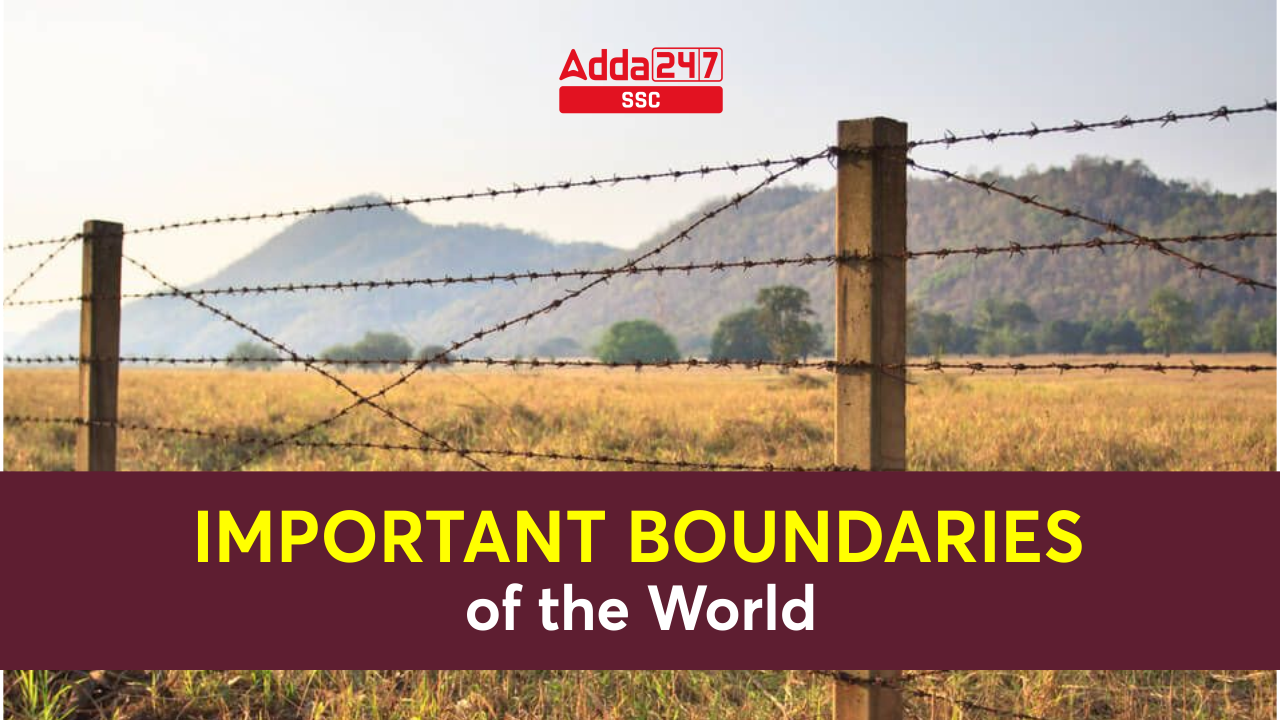Important Boundaries of the World
Important Boundaries of the World: This article explores significant boundaries around the world that act as dividing lines between nations. These boundaries play a crucial role in resolving disputes related to land ownership among different countries. Understanding these boundaries is essential, especially from an examination perspective, as it helps to comprehend geopolitical dynamics and historical conflicts. By studying these boundaries, one can gain valuable insights into the complex relationships between nations and the impact these divisions have on global politics and regional stability.
Some of the Important Boundaries of the World are explained below:
- The Durand Line is the 2,640-kilometer-long border between Afghanistan and Pakistan, named after Sir Mortimer Durand, a British diplomat who negotiated the border agreement in 1893 with the Afghan ruler at the time, Amir Abdur Rahman Khan. The Durand Line was established as the boundary between British India and Afghanistan, and it became the de facto border between Pakistan and Afghanistan after Pakistan’s independence in 1947.
- Hindenburg Line is the boundary dividing Germany and Poland. The Germans retreated to this line in 1917 during World War I. The Hindenburg Line, also known as the Siegfried Line, Named after German Field Marshal Paul von Hindenburg, the line was designed to protect Germany from Allied offensives and was built along the Western Front in northeastern France and Belgium.
- Mason-Dixon Line is a line of demarcation between 4 states in the United States: Pennsylvania, Maryland, Delaware, and West Virginia in the United States. The line was originally surveyed and established between 1763 and 1767 by two British surveyors, Charles Mason and Jeremiah Dixon, to settle a boundary dispute between the colonies of Maryland and Pennsylvania.
- Marginal Line was the 320-km line of fortification on the Russia-Finland border. Drawn up by General Mannerheim.
- Macmahon Line was drawn up by Sir Henry MacMahon, demarcating the frontier of India and China. China did not recognize the MacMahon line and crossed it in 1962. The MacMahon Line has been a source of dispute between India and China, with China rejecting the line as illegitimate and claiming parts of Arunachal Pradesh as its own territory. China claims that the line was never officially agreed upon by the Chinese government, and that it was imposed on China by the British during their colonial rule.
- Medicine Line is the border between Canada and the United States.
- Radcliffe Line was drawn up by Sir Cyril Radcliffe, demarcating the boundary between India and Pakistan. The line was named after Sir Cyril Radcliffe, a British lawyer who was appointed as the chairman of the Boundary Commission tasked with demarcating the boundary between the two newly created nations.
- Siegfried Line is the line of fortification drawn up by Germany on its border with France.
- Order-Neisse Line is the border between Poland and Germany, running along the Order and Neisse rivers, adopted at the Poland Conference (Aug 1945) after World War II.
- 17th Parallel defined the boundary between North Vietnam and South Vietnam before two were united.
- 24th Parallel is the line which Pakistan claims for demarcation between India and Pakistan. This, however, is not recognized by India
- 26th Parallel south is a circle of latitude which crosses through Africa, Australia and South America.
- 30th Parallel north is a line of latitude that stands one-third of the way between the equator and the North Pole.
- 33rd Parallel north is a circle of latitude which cuts through the southern United States, parts of North Africa, parts of the Middle East, and China.
- 35th Parallel north forms the boundary between the State of North Carolina and the State of Georgia and the boundary between the State of Tennessee arid the State of Georgia, the State of Alabama, and the State of Mississippi.
- 36th Parallel forms the southernmost boundary of the State of Missouri with the State of Arkansas.
- 37th Parallel north formed the southern boundary of the historic and extralegal Territory of Jefferson.
- 38th Parallel is the parallel of latitude which separates North Korea and South Korea.
- 39th Parallel north is an imaginary circle of latitude that is 39 degrees north of Earth’s equatorial plane.
- 40th Parallel north formed the original northern boundary of the British Colony of Maryland.
- 41st Parallel north forms the northern boundary of the State of Colorado with Nebraska and Wyoming and the southern boundary of the State of Wyoming with Colorado and Utah.
- 42nd Parallel north forms most of the New York – Pennsylvania Border.
- 43rd Parallel north forms most of the boundary between the State of Nebraska and the State of South Dakota and formed the northern border of the historic and extralegal Territory of Jefferson.
- 44th Parallel north is an imaginary circle of latitude that is 44 degrees north of the Earth’s equatorial plane.
- 45th Parallel north is often the halfway point between the Equator and the North Pole. The 45th parallel makes up most of the boundary between Montana and Wyoming.
- 49th Parallel is the boundary between USA and Canada.
| You may also like to read: | |
| Parliament of India | Dams in India |
| Union Territories in India | Largest State in India |



 SSC CGL 2025: Will the Number of Vacanci...
SSC CGL 2025: Will the Number of Vacanci...
 RRB ALP Preparation Strategy 2025, Tips ...
RRB ALP Preparation Strategy 2025, Tips ...
 SSC CGL 2025: Why It Will Be the Most Co...
SSC CGL 2025: Why It Will Be the Most Co...


